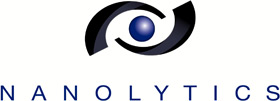
Nanolytics features the advanced 4-dimensional Multiwavelength Absorbance detector made by Nanolytics Instruments. For other unique detectors available in Nanolytics‘ lab, see below.
4D-AUC adds a spectral dimension to classical absorbance measurements. Where conventional absorbance detectors record intensities as a function of time and detector position at a fixed wavelength, the 4D-system collects entire spectra, typically from 200 to 900 nm. More than 2000 single wavelengths are comprised and can be extracted for individual or global data analysis.
Conventional absorbance detectors can be programmed to acquire scans at multiple wavelengths, but each wavelength requires an additional scan, thus limiting the maximum number of scans to be measured until the material has sedimented, or the number of samples to be run simultaneously. The multiwavelength detector requires less time for acquiring a scan of total spectra than a conventional detector takes for a single wavelength, allowing for a maximum of measurements during the course of the experiment.
4D-AUC offers a number of practical benefits. Though only a limited range inside the total spectrum will provide meaningful data, this usable part of the spectrum still contains dozens of usable single wavelengths. For single wavelength analysis, the suitable wavelength can be extracted afterwards, no prior knowledge on the spectral properties, concentration, and local extinction coefficients is required for conducting the experiment. This preserves sample amount and avoids any need for beforehand optimization. For multiple wavelengths to be analysed, spectral recording has the advantage that all data is acquired for absolutely reproducible wavelengths – other than for classical detectors with a moving monochromator grid with an error margin of several nanometers. This allows for precise data even at steep slopes of the spectrum.
These advantages apply for measurements where a single wavelength is sufficient for data analysis, just for the experimental benefits. The huge potential of 4D-AUC, however, lies in adding a spectral dimension to data analysis as well. As multiple species with individual spectral properties fractionate during the course of sedimentation, the sum of their absorbance signals is recorded. Appropriate software will allow for multiplex analysis, deconvoluting this signal into the corresponding contributions – identifying multiple species by their hydrodynamic and spectral properties.
Literature:
[1] Strauss HM, Karabudak E, Bhattacharyya S, Kretzschmar A, Wohlleben W, Coelfen H, Colloid Polym Sci (2008) 286:121–128
[2] Pearson J, Krause F, Haffke D, Demeler B, Schilling K, Coelfen H: Next Generation AUC (1): Multi-Wavelength Detectors for the Analytical Ultracentrifuge add a Spectral Dimension to AUC instrumentation, Methods in Enzymology, ed. J. Cole, 2015
AIDA – Advanced Interference Detection Array
The advanced interference optics, also made by Nanolytics Instruments, enhance the capabilities of interference detection. The interferograms recorded during the course of an AUC experiment yield a profile of differences in refractive number, thus monitoring all sedimenting or floating species, regardless their absorbance properties. This allows for discrimination of e. g. proteinaceous and non proteinaceous material. Interference detection accesses a large range of concentrations, but by state-of-the-art, it is limited to concentrations of 0.25 to 4-5 mg/mL (for typical proteins, according to the manufacturer). AIDA with its large and highly resolving CMOS sensor is more sensitive at low concentrations – we have achieved measurements at less than 50 µg/mL. Furthermore, it is capable of handling much higher concentrations – up to 140 mg/mL have been published for this detector. This is of particular interest for measuring highly concentrated antibody formulations at their actual concentration for patient administration.
The detector periscope has been equipped with superior optical components, allowing for perfect optical alignment. High performance image processing and optimized Fourier transform guarantee low noise and high precision output.
Turbidity optics
Nanolytics features a unique turbidity detection system, capable of detecting particles in a range up to 10 µm in diameter. The instrument is specifically designed for extremely polydisperse systems, extending the range of application by several orders of magnitude. The focus lies on synthetic colloidal particles from industrial processes.
Commercially available AUC encounter two limitations in respect to larger particles: (1) the minimum speed for measurements is at 3000 rpm, cutting off large particles that have sedimented before the AUC reached this minimum speed, and (2) large particles cause turbidity that neither classical absorbance nor detection systems can penetrate. Nanolytics Instruments‘ turbidity optics surpasses the limitations in detection, and the instrument is capable of performing a gravitational sweep experiment, gradually increasing rotor speed and multiplexing the light source in adaption to the variable speed. Registration starts with less than 1000 rpm, accounting for particles in the µm range, where particles down to a sub 10-nm-range are detected at higher speeds. Alike the 4D-AUC technique in absorbance, data are collected for the entire UV-Vis spectrum rather than for a single wavelength.

